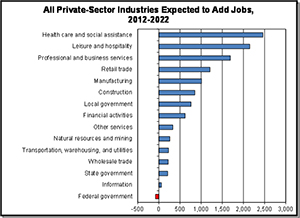Central Oregon (Crook, Deschutes and Jefferson Counties) is expected to add 12,140 jobs between 2012 and 2022, according to new projections from the Oregon Employment Department. This represents a 16 percent increase in employment over 10 years, exceeding the projected statewide growth of 15 percent. Much of this growth is expected to be driven by private-sector gains of 11,250 jobs (18 percent), with the public sector expected to add around 890 jobs (7 percent). Although Central Oregon is expected to experience some of Oregon’s fastest job growth, projected 2022 employment levels will only be about 1 percent (940 jobs) higher than peak pre-recession employment levels in 2007.
Beyond gains from economic growth, an additional 17,700 job openings will be created by 2022 as workers change occupations or leave for other reasons, such as retirement.
The 2012-2022 employment projections bring together several trends that have been building over the past few years: a growing health care sector, due in part to an aging population; continuing recovery from the Great Recession; and growth in tourism-related services.
Industry Projections
There will be job opportunities in all of the broad private-sector industry groups.
Central Oregon’s health care industry – which consists of outpatient clinics and medical offices, hospitals, and nursing and residential care facilities – is projected to add the most jobs (2,170), followed by leisure and hospitality (2,150), and professional and business services (1,690).
The region’s construction industry is expected to grow at the fastest rate, expanding by 26 percent (850 jobs). Even with this fast growth rate, construction employment will fall short of peak levels prior to the Great Recession. Other private industries expected to fall short of pre-recession employment levels by 2022 include manufacturing, financial activities, wholesale trade, information, and retail trade.
Information – which includes newspaper, directory, and book publishers, as well as software publishing and other firms – will be Central Oregon’s slowest-growing industry (4 percent), followed by local government (8 percent).
Federal government (-6 percent) is the only major industry sector expected to shed jobs over the decade.
Occupational Projections

Between 2012 and 2022, there will be 29,900 job openings in 610 different occupations in Central Oregon. About 17,700 of these openings will be to replace positions vacated due to retirement or other departures of existing workers, while about 12,200 openings will be due to economic growth. With the exception of construction and health care occupations, replacement openings will make up a majority of total job openings in all major occupational groups.
Service occupations – which include jobs as varied as emergency services, pest control workers, and fast food cooks – are projected to account for more job openings in Central Oregon than any other occupational group (7,692). In addition to service occupations, office and administrative support, sales, and professional occupational groups are each projected to generate more than 3,000 job openings.
Many of the fastest growing occupations are in health care due to an aging population and increased demand for health services. The top five fastest-growing large occupations include software developers, home health aides, medical secretaries, personal care aides, and cooks.
increased demand for health services. The top five fastest-growing large occupations include software developers, home health aides, medical secretaries, personal care aides, and cooks.
In terms of actual job counts, service occupations dominate the list. Retail salespersons, combined food preparation and serving workers, waiters and waitresses, cashiers, and customer service representatives are the five occupations with the most job openings anticipated in the 10-year period. These are all large occupations, and they will all experience openings due to economic growth, but many more openings will be due to existing workers leaving the occupation.
all experience openings due to economic growth, but many more openings will be due to existing workers leaving the occupation.
About 30 percent of job openings will require education beyond high school for entry into the occupation. However, just over 50 percent of the projected job openings will require some sort of education beyond high school in order for candidates to be more competitive in the hiring process. A bachelor’s degree or higher will be needed for about 22 percent of the openings at the competitive level.
Other Regional Projections and Additional Information
The Portland Metro area and Central Oregon will record the fastest employment growth over the 10-year period, according to projections made by the Employment Department’s regional economists. The Portland tri-county area consisting of Multnomah, Washington, and Clackamas counties anticipates 16 percent employment growth by 2022. The Central Oregon region made up of Deschutes, Crook, and Jefferson counties also expects employment gains of 16 percent. Lane County’s growth is expected to match the state’s, at 15 percent.
All employment projections are available on the Oregon Employment Department’s workforce and economic information website, QualityInfo.org. Select a region from the map and look in the Publications tab for statewide and regional projections by industry and occupation for 2012 to 2022.




